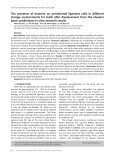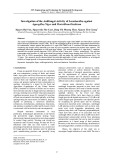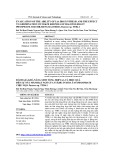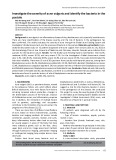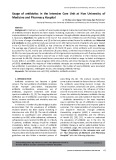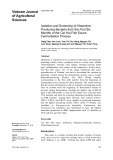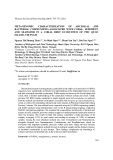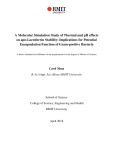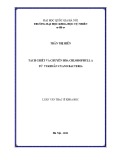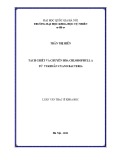doi:10.1046/j.1432-1033.2002.03248.x
Eur. J. Biochem. 269, 5484–5491 (2002) (cid:2) FEBS 2002
Equilibrium unfolding and conformational plasticity of troponin I and T
Samantha M. Martins, Alex Chapeaurouge and Se´ rgio T. Ferreira
Departamento de Bioquı´mica Me´dica, Universidade Federal do Rio de Janeiro, Brazil
TnT and TnI by guanidine hydrochloride and urea moni- tored by changes in far-UV CD and bis-ANS fluorescence revealed noncooperative folding transitions for both pro- teins and the existence of partially folded intermediate states. Taken together, these results indicate that isolated TnI and TnT are partially unstructured proteins, and suggest that conformational plasticity of the isolated subunits may play an important role in macromolecular recognition for the assembly of the troponin complex.
Keywords: troponin I; troponin T; urea; guanidine hydro- chloride; circular dichroism.
The structures and stabilities of recombinant chicken muscle troponin I (TnI) and T (TnT) were investigated by a com- bination of bis-ANS binding and equilibrium unfolding studies. Unlike most folded proteins, isolated TnI and TnT bind the hydrophobic fluorescent probe bis-ANS, indicating the existence of solvent-exposed hydrophobic domains in their structures. Bis-ANS binding to binary or ternary mix- tures of TnI, TnT and troponin C (TnC) in solution is sig- nificantly lower than binding to the isolated subunits, which can be explained by burial of previously exposed hydro- phobic domains upon association of the subunits to form the native troponin complex. Equilibrium unfolding studies of
interest resides in the elucidation of the structures and stabilities of TnI and TnT. To date, however, only the crystal structure of TnC has been solved [9]. Little is known low about structural details of TnT and TnI albeit resolution structures of TnI obtained from neutron scatter- ing studies are available [10,11]. In addition, part of the N-terminal region of TnI (amino acids residues1–47) has been cocrystallized with TnC [12].
Here, we present results from bis-ANS binding and equilibrium unfolding studies that indicate that TnI and TnT in isolation are both partially unstructured proteins. These results are discussed in terms of the possible role of conformational plasticity of TnI and TnT in the assembly of the native troponin complex.
E X P E R I M E N T A L P R O C E D U R E S
It is generally assumed that proteins must be fully folded in order to carry out their biological functions. In other words, biological activity and specificity are thought to be directly connected to a high degree of geometrical precision. However, recent studies call into question whether or not all functional proteins within the cell have stable secondary and tertiary structures [1,2]. Disorder in protein structures can be global or confined to certain domains. For example, the steroidogenic acute regulatory protein [3], the unligan- ded state of p21H–ras [4], and the cyclin-dependent kinase inhibitor p21Waf1/Cip1/Sdi1 [5] have been reported to be largely unfolded or only partially folded under physio- logical conditions. Locally disordered segments have also been found in eukaryotic transcription factors. A striking example is the basic DNA-binding region of the leucine zipper GCN4: while largely unstructured in the absence of DNA, it adopts a stable helical structure upon binding to its cognate AP-1 site [6].
Materials
Together with troponin C (TnC), TnI and TnT form the troponin complex, which is involved in the calcium- dependent regulation of skeletal and cardiac muscle con- traction [7]. In recent years, serum levels of TnI and TnT have become established as specific markers for myocardial infarction and unstable angina [8]. Because of their import- ance for the development of diagnostic tools, significant
Bis-ANS was from Molecular Probes (Junction City, OR, USA). Stock solutions of bis-ANS were prepared in methanol and the concentration was determined using the )1 [13]. Urea extinction coefficient, e360 ¼ 23 000 cm)1ÆM and guanidine hydrochloride were from Sigma Chem. Co (St Louis, MO, USA). All other reagents were of the highest grade commercially available.
Protein expression and purification
The plasmids for bacterial expression of chicken muscle TnI and TnT were a generous gift from C. S. Farah (University of Sa˜ o Paulo, Brazil). The recombinant proteins were expressed in Escherichia coli strain BL21(DE3)PlysS [14] and purified as previously described [15,16].
Expression and purification of recombinant chicken muscle a-tropomyosin was performed as described [17]. Actin and myosin were prepared from chicken pectoralis
Correspondence to S. T. Ferreira, Departamento de Bioquı´ mica Me´ dica, Universidade Federal do Rio de Janeiro, Rio de Janeiro, RJ 21941–590, Brazil. Fax: + 55 21 2562 6789, Tel.: + 55 21 2562 6789, E-mail: ferreira@bioqmed.ufrj.br Abbreviations: bis-ANS, 4,4¢-dianilino-1,1¢-binaphthyl-5,5¢-disul- phonic acid; GdnHCl, guanidine hydrochloride; TnI, troponin I; TnT, troponin T; TnC, troponin C. (Received 18 June 2002, revised 29 August 2002, accepted 10 September 2002)
Conformational plasticity of troponin I and T (Eur. J. Biochem. 269) 5485
(cid:2) FEBS 2002
free energy of unfolding in the absence of denaturant, and m-value) were also obtained by the Linear Extrapolation Method (LEM) according to Greene and Pace [22].
major and minor muscles and were a kind gift from M. M. Sorenson (Federal University of Rio de Janeiro, Brazil). Recombinant chicken muscle troponin C was kindly provi- ded by C. S. Farah. Protein concentrations were determined by the method of Hartree [18].
R E S U L T S
Biological activities of recombinant troponin I and T
Reconstitution of the troponin complex
In vitro reconstitution of the troponin ternary complex was performed as previously described [16]. Recombinant TnI, TnT and TnC (20 lM of each) were mixed in buffer containing 6 M urea, 25 mM Tris/HCl ( pH 8.0), 1 M KCl, 50 lM CaCl2 and 1 mM dithiothreitol. Successive steps of dialysis (4 (cid:3)C, 12 h each) against the same buffer containing 4.6 M urea, 2 M urea, no urea, 100 mM KCl and 6.5 mM KCl were used to gradually reduce the concentrations of urea and salt. After dialysis, the reconstituted complexes were centrifuged (12 000 g, 10 min) and the supernatant was aliquoted and stored at )70 (cid:3)C.
Fluorescence measurements
In order to ascertain that the recombinant TnI and TnT used in the present study were biologically functional, we first analyzed the ability of a reconstituted troponin complex to regulate actomyosin Mg2-ATPase activity. For this purpose, the troponin complex was reconstituted from isolated recombinant troponin subunits as described in experimental procedures. This assay showed that the reconstituted troponin complex confered sensitivity to calcium regulation to the actomyosin ATPase to the same extent as previously described [16] (data not shown). In addition, the capacity of purified recombinant TnI to inhibit the actomyosin ATPase activity was also investigated. As previously reported [23], the actomyosin ATPase was inhibited in a dose-dependent manner by TnI (not shown). We have also determined that, in the presence of calcium, recombinant TnI and TnC formed binary complexes that resisted dissociation in urea-PAGE gels (not shown), as previously reported [23]. Taken together, the results des- cribed above indicate that the recombinant TnI and TnT used in this study retain their expected biological activities and the capacity to establish specific interactions with other troponin subunits.
Analysis of the CD spectra of TnI and TnT
All experiments were carried out in 25 mM Tris/HCl, pH 7.4, 200 mM KCl, 1 mM dithiothreitol, using 4 or 10 lM bis-ANS (as indicated in the legends to the figures) and 2 lM TnI or 1 lM TnT. Fluorescence data were acquired on a F4500 Hitachi spectrofluorometer at 25 (cid:3)C. Bis-ANS emission spectra were measured from 400 to 600 nm (kexc ¼ 365 nm) with slit widths of 10 nm. For equilibrium unfolding experiments, samples were incubated for 12 h at 25 (cid:3)C in the presence of the indicated concentrations of guanidine hydrochloride (GdnHCl) or urea prior to fluor- escence measurements.
Interactions between different troponin subunits were investigated in medium containing 25 mM Tris/HCl, pH 7.4, 100 lM free CaCl2 (or 1 mM EGTA in the experiments without calcium), 200 mM KCl (or 6.5 mM in the experiments with reconstituted troponin complex), 3.5 mM MgCl2, 2 mM dithiothreitol, 10 lM bis-ANS and 1 lM of each troponin subunit or of the previously reconstituted troponin ternary complex.
Circular dichroism
Fig. 1A shows far UV-CD spectra for isolated TnI and TnT. Analysis of the spectra was performed using the CDPro package [19], which allows evaluation of the robustness of the analysis by comparing the results obtained using three independent algorithms (CONTINLL, SELCON3 and CDSSTR) that use the same database of proteins with known three-dimensional structure. This analysis yielded a-helix and b-sheet contents of 17 ± 2% and 33 ± 5%, respectively, for TnI, and 24 ± 4% and 25 ± 2%, respect- ively, for TnT. It is interesting to note that, for both proteins, approximately 50% of the amino acid residues were not found to take part in standard secondary structure elements. This result is similar to that previously reported for TnI and TnT purified from rabbit muscle [24].
Intrinsic fluorescence emission of troponin I and T
CD studies were performed on a Jasco J-720 spectropola- rimeter at 25 (cid:3)C using TnI (12 lM) or TnT (6 lM) in 10 mM Tris/HCl, pH 7.4, 500 mM KCl, 2 mM EGTA and 1 mM dithiothreitol. A cylindrical cell with a path-length of 0.1 cm was used. The results are expressed as mean residue ellipticity. For equilibrium unfolding experiments, samples were incubated for 12 h at 25 (cid:3)C in the presence of the indicated concentrations of GdnHCl or urea before meas- urements. Spectra were measured from 200 to 270 nm. CD data were analyzed using the CDPro package as previously described [19].
Data analysis
Chicken skeletal muscle TnI and TnT have one and three tryptophan residues, respectively [25,26]. This raised the possibility that their intrinsic fluorescence emission could be used to investigate their thermodynamic stabilities. How- ever, preliminary measurements showed that both proteins exhibited fluorescence emission maxima at (cid:2)350 nm (data not shown), characteristic of tryptophan side chains that are fully exposed to the aqueous medium. In addition, for both proteins only minor changes in fluorescence intensity were observed in the absence or in the presence of 5 M guanidine hydrochloride (data not shown). Thus, for both TnI and TnT the intrinsic fluorescence emission was found not to be suitable to monitor their unfolding transitions.
Denaturation data were fitted by nonlinear least-squares analysis. Fits to a two-state denaturation model followed the equation described by Rietveld and Ferreira [20], and fits to a three-state denaturation model followed the equation des- cribed by Tendian et al. [21]. Fitting parameters (DGH2O , the
u
5486 S. M. Martins et al. (Eur. J. Biochem. 269)
(cid:2) FEBS 2002
Interaction of bis-ANS with troponin I and T
Bis-ANS is an environment-sensitive fluorescent probe that shows an emission maximum at 533 nm in aqueous medium [27]. Binding to exposed hydrophobic domains in proteins brings about a large increase in bis-ANS fluorescence emission intensity and a blue-shift of the emission maximum [28]. Titration of TnI and TnT solutions with increasing concentrations of bis-ANS indicated saturation of binding at 4 and 10 lM bis-ANS, respectively (data not shown). Figure 1B shows bis-ANS fluorescence emission spectra in the presence of TnI and TnT. For both proteins, the fluorescence quantum yield of bis–ANS increased markedly and the maximum emission wavelength was blue shifted compared to the emission of bis-ANS in aqueous buffer alone (Fig. 1C). This indicates the existence of solvent exposed hydrophobic domains in isolated TnI and TnT in solution.
Interactions between troponin subunits
In order to investigate whether the bis-ANS binding sites in isolated TnI and TnT could be related to sites of interaction between troponin subunits, the experiments shown in Fig. 2 were performed. Bis-ANS binding to isolated TnI, TnT or TnC was compared to binding to binary mixtures of these proteins or to the previously reconstituted troponin ternary complex as described in experimental procedures. The arithmetic sum of bis-ANS fluorescence intensities meas- ured in the presence of each isolated protein should equal the intensity experimentally measured in the presence of the binary or ternary complexes if bis-ANS binding was unaffected by the interaction between troponin subunits. By contrast, we experimentally found that the fluorescence intensity of bis-ANS in the presence of the binary mixture of troponin I–T was (cid:2)21%, lower than the sum of the fluorescence intensities measured for each isolated protein (Fig. 2A). This indicates that part of the exposed hydro- phobic sites of TnI and TnT occupied by bis-ANS may constitute regions of interaction between these proteins. In the presence of calcium (but not in its absence), bis-ANS fluorescence in the presence of the binary TnI/TnC complex
Fig. 1. Far-UV CD spectra of TnI and TnT and binding of bis-ANS. (A) CD spectra of samples containing 12 lM TnI or 6 lM TnT in 25 mM Tris/HCl (pH 7.4), 500 mM KCl, 2 mM EGTA and 1 mM dithiothre- itol. (B) Fluorescence emission spectra of bis-ANS in the presence of TnI or TnT. Spectra were measured using 2 lM TnI/4 lM bis-ANS or 1 lM TnT/10 lM bis-ANS in 25 mM Tris/HCl (pH 7.4), 200 mM KCl, 2 mM EGTA and 1 mM dithiothreitol. For comparison, the spectrum of bis-ANS (10 lM) in aqueous buffer is shown in the same scale in (C).
Fig. 2. Interaction between troponin subunits monitored by changes in bis-ANS fluorescence intensity. Control fluorescence intensities (100%, hatched bars) correspond to the sums of bis-ANS fluorescence intensities measured in the presence of the individual troponin subunits. (A) TnI–TnT interaction. (B) TnI–TnC interaction in the absence (black bar) or in the presence of calcium (white bar). (C) TnI–TnT–TnC interaction; the black bar corresponds to the fluorescence of bis-ANS added to a mixture of the three troponin subunits, and the white bar corresponds to the fluorescence of bis-ANS added to previously reconstituted troponin complex (as described in Experimental procedures). Assay conditions: 25 mM Tris/HCl (pH 7.4), 100 lM free CaCl2 (or 1 mM EGTA in experiments in the absence of calcium), 200 mM KCl (6.5 mM in the experiments with reconstituted troponin complex), 3.5 mM MgCl2, 2 mM dithiothreitol and 10 lM bis-ANS. In all panels, protein concentration was 1 lM for each troponin subunit or for the reconstituted troponin complex.
Conformational plasticity of troponin I and T (Eur. J. Biochem. 269) 5487
(cid:2) FEBS 2002
was (cid:2)37% lower than the sum of the fluorescence intensities measured for each protein separately (Fig. 2B).
No difference in bis-ANS fluorescence intensity was observed in TnT–TnC binary mixtures relative to the sum of the intensities measured with each protein alone (data not shown). As TnT–TnC interaction is thought to occur under the experimental conditions we have used [29], this result suggests that the interaction between these proteins does not involve hydrophobic domains involved in bis-ANS binding. Bis-ANS binding to the ternary troponin complex was also analyzed (Fig. 2C). The fluorescence emission of bis- ANS added to a mixture of the three troponin subunits was 45% lower than the sum of the intensities observed with the three isolated subunits. Furthermore, the fluorescence of bis-ANS in the presence of previously reconstituted tropo- nin complex was (cid:2) 62% lower than the sum of individual fluorescence intensities. These results indicate that bis-ANS binding monitors hydrophobic sites that are involved in the interaction between troponin subunits in the assembly of the native ternary complex.
Unfolding of TnI and TnT by guanidine hydrochloride
Structural changes in TnI and TnT induced by GdnHCl were monitored by bis-ANS fluorescence and far-UV CD spectroscopy. Maximal binding of bis-ANS to TnI and TnT was observed in the absence of GdnHCl (Fig. 3). For both proteins, addition of 1 M GdnHCl caused a dramatic decrease in bis-ANS fluorescence, suggesting a major disor- ganization of bis-ANS binding sites. The fact that relatively low GdnHCl concentrations caused such large decreases in bis-ANS fluorescence intensity raised the possibility that, other than or in addition to inducing conformational transitions in TnI and TnT, GdnHCl might directly affect bis-ANS binding to the proteins. This could be due to the high ionic strength of GdnHCl solutions, which could interfere with the interactions between sulfonate groups of bis-ANS and positively charged residues in the proteins. To investigate this hypothesis, bis-ANS binding to TnI and TnT was monitored in the presence of increasing KCl concentra- tions in the same range of GdnHCl concentrations used. Addition of up to 1 M KCl caused no changes in bis-ANS fluorescence intensities (data not shown), which ruled out the possibility that high ionic strength alone could lead to the release of bound bis-ANS. In addition, this result suggests that bis-ANS binding to TnI and TnT is not significantly stabilized by electrostatic interactions, in line with previous studies of bis-ANS binding to other proteins [30].
Circular dichroism measurements revealed a loss of only (cid:2) 22% of the secondary structure of TnT at GdnHCl concentrations that caused major decreases in bis-ANS fluorescence (i. e. up to 1 M GdnHCl; Fig. 3B). Significant loss of TnT secondary structure took place only at higher concentrations of GdnHCl. In the case of TnI, (cid:2) 60% of the CD change coincided with the change in bis-ANS fluores- cence up to 1 M GdnHCl (Fig. 3A). These results suggest that low stability segments of TnI are involved in (or responsible for) binding bis-ANS.
Unfolding of troponin I and T by urea
GdnHCl, higher urea concentrations were required to cause release of bound bis-ANS from both proteins. It has previously been suggested that protein denaturation by urea
Bis-ANS binding to TnI and TnT was maximal in the absence of urea (Fig. 4). Compared to the unfolding by
Fig. 3. Denaturation of TnI and TnT by guanidine hydrochloride. Experimental conditions for fluorescence and CD measurements are described in Experimental procedures. Symbols correspond to relative bis-ANS fluorescence intensity (d) or mean residue ellipticity at 222 nm (h). Two-state (dashed line) and three-state unfolding fits (solid line) to the experimental data are shown. Open circles represent bis-ANS fluorescence measurements after removal of the denaturant by dialysis of samples previously incubated in the presence of 1 M or 2 M GdnHCl for TnI or TnT, respectively. The figure also shows plots of the residuals of two-state (h) and three-state (j) fits to the CD data. Values are means ± SD for three experiments in each condition.
5488 S. M. Martins et al. (Eur. J. Biochem. 269)
(cid:2) FEBS 2002
large differences in stability of both TnI and TnT towards GdnHCl and urea, we investigated the contributions of electrostatic interactions to their stabilities. Indeed, unfold- ing of both proteins by urea in the presence of 500 mM KCl required substantially lower urea concentrations, indicating that electrostatic interactions contribute effectively to the stabilities of TnI and TnT (data not shown).
Unfolding of TnI and TnT by urea monitored by circular dichroism showed clear deviations from a two-state mech- anism. For both proteins, significant loss of secondary structure was observed in the same range of urea concen- trations that caused the release of bound bis ANS (Fig. 4). However, as in the case of GdnHCl induced unfolding, complete loss of secondary structure was only observed at higher urea concentrations.
Analyses of TnI and TnT unfolding curves
TnI and TnT unfolding data were analyzed according to two- and three-state unfolding models. Figures 3 and 4 show the experimental data and fits for both proteins in the presence of GdnHCl and urea, respectively. With both denaturants, CD data for TnI and TnT are better described by three-state fits than by two-state fits (see residuals plots shown in Figs 3 and 4), indicating the presence of at least one intermediate state in the equilibrium unfolding of these proteins. On the other hand, with both denaturants two- state fits are shown for TnI and TnT bis-ANS fluorescence data, as three-state fits did not yield statistically superior results (Figs 3 and 4). Thermodynamic parameters for the unfolding transitions of both proteins were calculated and are shown in Tables 1 and 2. For both proteins, the DG values obtained from the analysis of fluorescence and CD changes were found to be dependent on the denaturant used. It is well known that different estimates of protein stability may be obtained when guanidine or urea are used as denaturants. This may be related to the high ionic strength of guanidine solutions, which often leads to screening of electrostatic interactions that are important for protein stability [31]. Thus, the result that different DG values were obtained using different denaturants for both proteins (compare Tables 1 and 2) may reflect different contributions of electrostatic interactions to the overall stabilities of TnI and TnT.
D I S C U S S I O N
(a noncharged solute) reflects more closely the global stability of a protein, while the high ionic strength of GdnHCl solutions may effectively screen the contributions from electrostatic interactions to protein stability [31]. This could explain the differences in concentrations of GdnHCl and urea usually required to unfold proteins. Given the
Although the mechanism by which the troponin complex regulates muscle contraction is currently known in consid- erable detail, very little is known about the structures and stabilities of TnT and TnI prior to their incorporation into the functional ternary complex. This is partly due to the fact that neither TnI nor TnT are sufficiently soluble to allow studies employing high resolution structural methods such as X-ray crystallography or NMR spectrometry. In fact, isolated TnI and TnT tend to aggregate at physiological pH and low salt concentrations. Here, we have carried out biophysical (fluorescence and CD) studies of isolated TnI and TnT to gain insight into their solution structures. Fluorescence and CD spectroscopies require significantly lower sample concentrations (typically in the low micro- molar range), enabling us to study TnI and TnT under conditions in which they remain soluble.
Fig. 4. Denaturation of TnI and TnT by urea. Symbols correspond to relative bis-ANS fluorescence intensity (d) or mean residue ellipticity at 222 nm (h). Two-state (dashed line) and three-state unfolding fits (solid line) to the experimental data are shown. Open circles represent bis-ANS fluorescence measurements after removal of the denaturant by dialysis of samples previously incubated in the presence of 2 M or 3 M urea for TnI and TnT, respectively. The figure also shows plots of the residuals of two-state (open squares) and three-state (closed squares) fits to the CD data. Values are means ± SD for three experiments in each condition.
Conformational plasticity of troponin I and T (Eur. J. Biochem. 269) 5489
(cid:2) FEBS 2002
Table 1. Thermodynamic parameters for the unfolding of troponin I by guanidine hydrochloride and urea. DG (kcalÆmol)1) is the free energy of unfolding in the absence of denaturant, m (kcal/(molÆM)) is a factor proportional to the change in accessible surface area (DASA; [38]) of the protein upon unfolding. Thermodynamic parameters were calculated by the linear extrapolation method [22]. Three-state fits to the fluorescence data did not result in statistically superior results and are not shown. Values are averages ± standard deviations for three experiments in each condition.
Two-state fit Three-state fit
m Denaturant Technique DG DG1 DG2 DGtotal m1 m2
GdnHCl CD Fluorescence 1.5 ± 0.3 1.1 ± 0.08 2.3 ± 0.5 2.8 ± 0.07 1.4 ± 0.1 – 2.6 ± 0.4 – 4.0 ± 0.5 – 2.8 ± 0.2 – 2.2 ± 0.07 –
Urea CD Fluorescence 1.7 ± 0.2 1.4 ± 0.1 0.8 ± 0.05 1.4 ± 0.1 0.4 ± 0.01 – 2.0 ± 0.1 – 2.4 ± 0.1 – 0.3 ± 0.1 – 0.9 ± 0.1 –
Table 2. Thermodynamic parameters for the unfolding of troponin T by guanidine hydrochloride and urea. DG (kcalÆmol)1) is the free energy of unfolding in the absence of denaturant, m (kcal/(molÆM)) is a factor proportional to the change in accessible surface area (DASA; [38]) of the protein upon unfolding. Thermodynamic parameters were calculated by the linear extrapolation method [22]. Three-state fits to the fluorescence data did not result in statistically superior results and are not shown. Values are averages ± standard deviations for three experiments in each condition.
Two-state fit Three-state fit
m DG Denaturant Technique DG1 DG2 DGtotal m1 m2
GdnHCl CD Fluorescence 1.85 ± 0.3 2.0 ± 0.05 1.5 ± 0.01 4.2 ± 0.3 1.6 ± 0.03 – 1.0 ± 0.2 – 2.6 ± 0.2 – 1.2 ± 0.2 – 0.9 ± 0.07 –
significantly lower
Analysis of circular dichroism data indicates that (cid:2) 50% of the amino acids residues of both TnI and TnT are not involved in standard secondary structure elements. Furthermore, the binding of bis-ANS observed for both isolated TnI and TnT suggests the existence of solvent- exposed hydrophobic domains in both proteins. These results are consistent with previous phosphorylation studies that suggested that TnI and TnT contain elongated and solvent accessible domains [32–34]. Thus, isolated TnI and TnT in solution can probably be best described as signifi- cantly unstructured nonglobular proteins.
dumb-bell shape in isolation [12]. The TnI1–47 fragment forms a 31-residue a-helix and interacts by multiple hydrophobic interactions with both TnC lobes. Consistent with these results, the association of recombinant TnI and TnC is accompanied by a drop in bis-ANS fluorescence intensity (Fig. 2B). Interestingly, the bis-ANS fluorescence in the presence of previously reconstituted troponin ternary than the fluorescence complex is observed in the presence of a mixture of TnI, TnT, and TnC. This may indicate that assembly of the troponin complex in vivo is a highly cooperative process that takes place in concert with folding of the subunits, rather than a trimerization of previously folded monomers. In summary, bis-ANS binding studies of TnI and TnT in isolation, as well as in complexes with each other and with TnC, imply that dimerization and trimerization induce significant conform- ational changes that are accompanied by internalization of previously exposed hydrophobic surfaces.
Folding of small, single domain proteins is generally considered to be a cooperative two-step transition. Ther- modynamic analysis of the folding process of TnT and TnI monitored by CD and fluorescence changes, however, revealed noncooperative three-state transitions for both proteins, which can be described by the following model:
F $ I $ U
Interaction sites between TnI and TnT have recently been examined using the yeast two-hybrid system [35]. The results indicate that TnI and TnT contain highly conserved heptad repeat motifs, which are likely to form a-helical coiled-coils upon assembly. Those studies also revealed that formation of TnT–TnI heterodimers is favoured over TnT–TnT and TnI–TnI homodimers. In addition, it has been reported that fast skeletal muscle TnT binds to dystrophin by coiled-coil or leucine zipper mediated interactions [36]. The heptad repeats are characterized by the presence of hydrophobic residues at positions a and d in a seven amino acid motif. The binding of bis-ANS to TnI and TnT might be associated with these hydrophobic residues (Fig. 2), which are likely exposed to the solvent in the isolated proteins. Because hydrophobic residues become buried within the hydrophobic core upon coiled-coil formation, the lower bis- ANS fluorescence observed in solutions containing TnI and TnT could be explained by heterodimerization (Fig. 2A). The crystal structure of TnC in complex with the N-terminal fragment of TnI (TnI1–47) and Ca2+ reveals that TnC has a compact globular shape, in sharp contrast with its elongated
where F is the folded state, I is a partially folded intermediate state and U represents a fully unfolded state. Similar results have been reported for human cardiac TnI [37]. Thus, the structural plasticity of TnI and TnT is also reflected in noncooperative transitions from the unfolded to the partially folded states.
Urea CD Fluorescence 1.4 ± 0.3 1.5 ± 0.1 0.45 ± 0.06 1.1 ± 0.05 1.0 ± 0.06 – 2.3 ± 0.3 – 3.3 ± 0.4 – 0.4 ± 0.02 – 0.6 ± 0.02 –
5490 S. M. Martins et al. (Eur. J. Biochem. 269)
(cid:2) FEBS 2002
8. Frostfeldt, G., Gustafsson, G., Lindahl, B., Nygren, A., Venge, P. & Wallentin, L. (2001) Possible reasons for the prognostic value of troponin-T on admission in patients with ST-elevation myocardial infarction. Coron. Artery Dis. 12, 227–237.
9. Herzberg, A. & James, M.N.G. (1985) Structure of the calcium regulatory muscle protein troponin-C at 2.8-A˚ resolution. Nature 313, 653–659.
The m-values obtained from equilibrium unfolding studies using chemical denaturants have been suggested to reflect the change in accessible surface area (DASA) upon folding of small single-domain proteins [38]. Interestingly, the m-values found for TnI and TnT (Tables 1 and 2) do not fall within the range of DASA predicted for proteins of their molecular weights [38]. This suggests that m-values obtained from unfolding studies of partially unstructured proteins do not properly reflect changes in DASA, and indicates that care must be taken in the interpretation of equilibrium unfolding data of such proteins.
While certain biological
10. Olah, G. & Trewhella, J. (1994) A model structure of the muscle protein complex 4Ca2+Ætroponin CÆtroponin I derived from small- angle scattering data: implications for regulation. Biochemistry 33, 12800–12806.
11. Stone, D.B., Timmins, P.A., Schneider, D.K., Krylova, I., Ramos, C.H.I., Reinach, F.C. & Mendelson, R.A. (1998) The effect of regulatory Ca2+ on the in situ structures of troponin C and troponin I: a neutron scattering study. J. Mol. Biol. 281, 689–704.
12. Vassylyev, D.G., Takeda, S., Wakatsuki, S., Maeda, K. & Maeda, Y. (1998) Crystal structure of troponin C in complex with tro- ponin I fragment at 2.3-A˚ resolution. Proc. Natl Acad. Sci. USA 95, 4847–4852. 13. Haugland, R.P. (1996) Handbook of Fluorescent Probes and Research Chemicals. Molecular Probes, Inc, Eugene, OR.
14. Studier, F.W., Rosenberg, A.H., Dunn, J.J. & Dubendorff, J.W. (1990) Use of T7 RNA polymerase to direct expression of cloned genes. Methods Enzymol. 185, 60–89.
functions, such as enzyme catalysis, demand precise three-dimensional structures, other functions such as signalling can possibly be achieved by simpler secondary structural motifs [39]. Recently, ideas about potential biological advantages of several partially unfolded protein structures have been discussed [1,2]. Unstructured proteins may be shaped more easily by their environment and intrinsic structural plasticity may allow them to recognize a larger number of biological targets and ligands. In addition, simulation studies of binding have suggested that a relatively unstructured protein can have a greater capture radius for a specific binding site than a folded state with its restricted conformational freedom [40]. Thus, the conformational plasticity of TnI and TnT could provide both proteins with the ability to adapt their conformations to a variety of different environments and biological partners as required to form a functional unit such as the troponin complex.
15. Quaggio, R.B., Ferro, J.A., Monteiro, P.B. & Reinach, F.C. (1993) Cloning and expression of chicken skeletal muscle troponin I in Escherichia coli: the role of rare codons on the expression level. Protein Sci. 2, 1053–1056.
16. Malnic, B., Farah, C.S. & Reinach, F.C. (1998) Regulatory properties of the NH2- and COOH-terminal domains of troponin T. ATPase activation and binding to troponin I and troponin C. J. Biol. Chem. 273, 10594–10601.
A C K N O W L E D G E M E N T S
17. Monteiro, P.B., Lataro, R.C., Ferro, J.A. & Reinach, F.C. (1994) Functional alpha-tropomyosin produced in Escherichia coli. A dipeptide extension can substitute the amino-terminal acetyl group. J. Biol. Chem. 269, 10461–10466.
18. Hartree, E.F. (1972) Determination of protein: a modification of the Lowry method that gives a linear photometric response. Anal. Biochem. 48, 422–427.
This work was supported by grants from Conselho Nacional de Desenvolvimento Cientifico e Tecnologico (CNPq), Programa de Apoio ao Desenvolvimento Cientifico e Tecnolo´ gico (PADCT), Fundac¸ a˜ o de Amparo a` Pesquisa do Estado do Rio de Janeiro (FAPERJ), The John Simon Guggenheim Memorial Foundation and Howard Hughes Medical Institute. S.M.M. was recipient of a CNPq fellowship.
19. Sreerama, N. & Woody, R.W. (2000) Estimation of protein sec- ondary structure from circular dichroism spectra: comparison of CONTIN, SELCON, and CDSSTR methods with an expanded reference set. Anal. Biochem. 287, 252–260.
R E F E R E N C E S
20. Rietveld, A.W.M. & Ferreira, S.T. (1998) Kinetics and energetics of subunit dissociation/unfolding of TIM: the importance of oligomerization for conformational persistence and chemical stability of proteins. Biochemistry 37, 933–937. 1. Wright, P.E. & Dyson, H.J. (1999) Intrinsically unstructured proteins: Re-assessing the protein structure-function paradigm. J. Mol. Biol. 293, 321–331. 2. Uversky, V.N. (2002) What does it mean to be natively unfolded? Eur. J. Biochem. 269, 2–12.
21. Tendian, S.W., Myszka, D.G., Sweet, R.W., Chaiken, I.M. & Brouillette, C.G. (1995) Interdomain communication of T-cell CD4 studied by absorbance and fluorescence difference spectro- scopy measurements of urea-induced unfolding. Biochemistry 34, 6464–6474.
3. Bose, H.S., Whittal, R.M., Baldwin, M.A. & Miller, W.L. (1999) The active form of the steroidogenic acute regulatory protein, StAR, appears to be a molten globule. Proc. Natl Acad. Sci. USA 96, 7250–7255.
4. Zhang, J. & Matthews, C.R. (1998) Ligand binding as the principal determinant of stability for the p21 (H-ras) protein. Biochemistry 37, 14881–14890.
22. Greene, R.F. & Pace, C.N. (1974) Urea and guanidine hydro- chloride denaturation of ribonuclease, lysozyme, alpha-chymo- trypsin, and beta-lactoglobulin. J. Biol. Chem. 249, 5388–5393. 23. Farah, C.S., Miyamoto, C.A., Ramos, C.H.R., Da Silva, A.C.R., Quaggio, R.B., Fujimori, K., Smillie, L.B. & Reinach, F.C. (1994) Structural and regulatory functions of the NH2- and COOH- terminal regions of skeletal muscle troponin I. J. Biol. Chem. 269, 5230–5240. 5. Kriwacki, R.W., Hengst, L., Tennant, L., Reed, S.I. & Wright, P.E. (1996) Structural studies of p21 (Waf1/Cip1/Sdi1) in the free and CdK2-bound state: Conformational disorder mediates bind- ing diversity. Proc. Natl Acad. Sci. USA 93, 11504–11509.
24. Wu, C.-S.C. & Yang, J.T. (1976) Reexamination of the con- formation of muscle proteins by optical activity. Biochemistry 15, 3007–3014.
6. Weiss, M.A., Ellenberger, T., Wobbe, C.R., Lee, J.P., Harrison, S.C. & Struhl, K. (1990) Folding transition in the DNA-binding domain of GCN4 on specific binding to DNA. Nature 347, 575– 578. 7. Tobacman, L.S. (1996) Thin filament-mediated regulation of 25. Wilkinson, J.M. & Grand, R.J. (1978) The amino-acid sequence of chicken fast-skeletal-muscle troponin I. Eur. J. Biochem. 82, 493–501. cardiac contraction. Annu. Rev. Physiol. 58, 447–481.
Conformational plasticity of troponin I and T (Eur. J. Biochem. 269) 5491
(cid:2) FEBS 2002
33. Kumon, A. & Villar-Palasi, C. (1979) Purification and properties of troponin T kinase from rabbit skeletal muscle. Biochim. Bio- phys. Acta 566, 305–320. 26. Smillie, L.B., Golosinska, K. & Reinach, F.C. (1988) Sequences of complete cDNAs encoding four variants of chicken skeletal muscle troponin T. J. Biol. Chem. 263, 18816–18820.
induced by 1,1¢-bis 34. Huang, T.S., Bylund, D.B., Stuil, J.T. & Krebs, E.J. (1974) The amino acid sequences of the phosphorylated sites in troponin-I from rabbit skeletal muscle. FEBS Lett. 42, 249–252.
27. Shi, L., Palleros, D.R. & Fink, A.L. (1994) Protein conformational changes (4-anilino-5-naphthalenesulfonic acid): preferential binding to the molten globule of DnaK. Biochemistry 33, 7536–7546. 28. Das, K.P. & Surewicz, W.K.
35. Stefancsik, R., Jha, P.K. & Sarkar, S. (1998) Identification and mutagenesis of a highly conserved domain in troponin T responsible for troponin I binding: potential role for coiled coil interaction. Proc. Natl Acad. Sci. USA 95, 957–962. (1995) Temperature-induced exposure of hydrophobic surfaces and its effect on the chaperone activity of alpha-crystallin. FEBS Lett. 369, 321–325.
36. Pearlman, J.A., Powaser, P.A., Elledge, S.J. & Caskey, C.T. (1994) Troponin T is capable of binding dystrophin via a leucine zipper. FEBS Lett. 354, 183–186. 29. Tanokura, M., Tawado, Y., Ono, A. & Ohtsuki, I. (1983) Chy- motryptic subfragments of troponin T from rabbit skeletal muscle. Interaction with tropomyosin, troponin I and troponin C. J. Biochem. 93, 331–337.
37. Morjana, N. & Tal, R. (1998) Expression and equilibrium dena- turation of cardiac troponin I: stabilization of a folding inter- mediate during denaturation by urea. Biotechnol. Appl. Biochem. 28, 7–17. 30. Bothra, A., Bhattacharyya, A., Mukhopadhyay, C., Bhattachar- yya, K. & Roy, S. (1998) A fluorescence spectroscopic and study of bis-ANS/protein interaction. molecular dynamics J. Biomol. Struct. Dyn. 15, 959–966.
38. Myers, J.K., Pace, N. & Scholtz, J.M. (1995) Denaturant m values and heat capacity changes: relation to changes in accessible surface areas of protein unfolding. Protein Sci. 4, 2138–2148.
31. Monera, O.D., Kay, C.M. & Hodges, R.S. (1994) Protein dena- turation with guanidine hydrochloride or urea provides a different estimate of stability depending on the contributions of electrostatic interactions. Protein Sci. 3, 1984–1991.
39. Geyer, M., Fackler, O.T. & Peterlin, B.M. (2001) Structure- function relationships in HIV-1 Nef. EMBO Report 2, 580–585. 40. Shoemaker, B.A., Portman, J.J. & Wolynes, P.G. (2000) Speeding molecular recognition by using the folding funnel: the fly-casting mechanism. Proc. Natl Acad. Sci. USA 97, 8868–8873. 32. Perry, S.V. & Cole, H.A. (1974) Phosphorylation of troponin and the effects of interactions between the components of the complex. Biochem. J. 141, 733–743.



